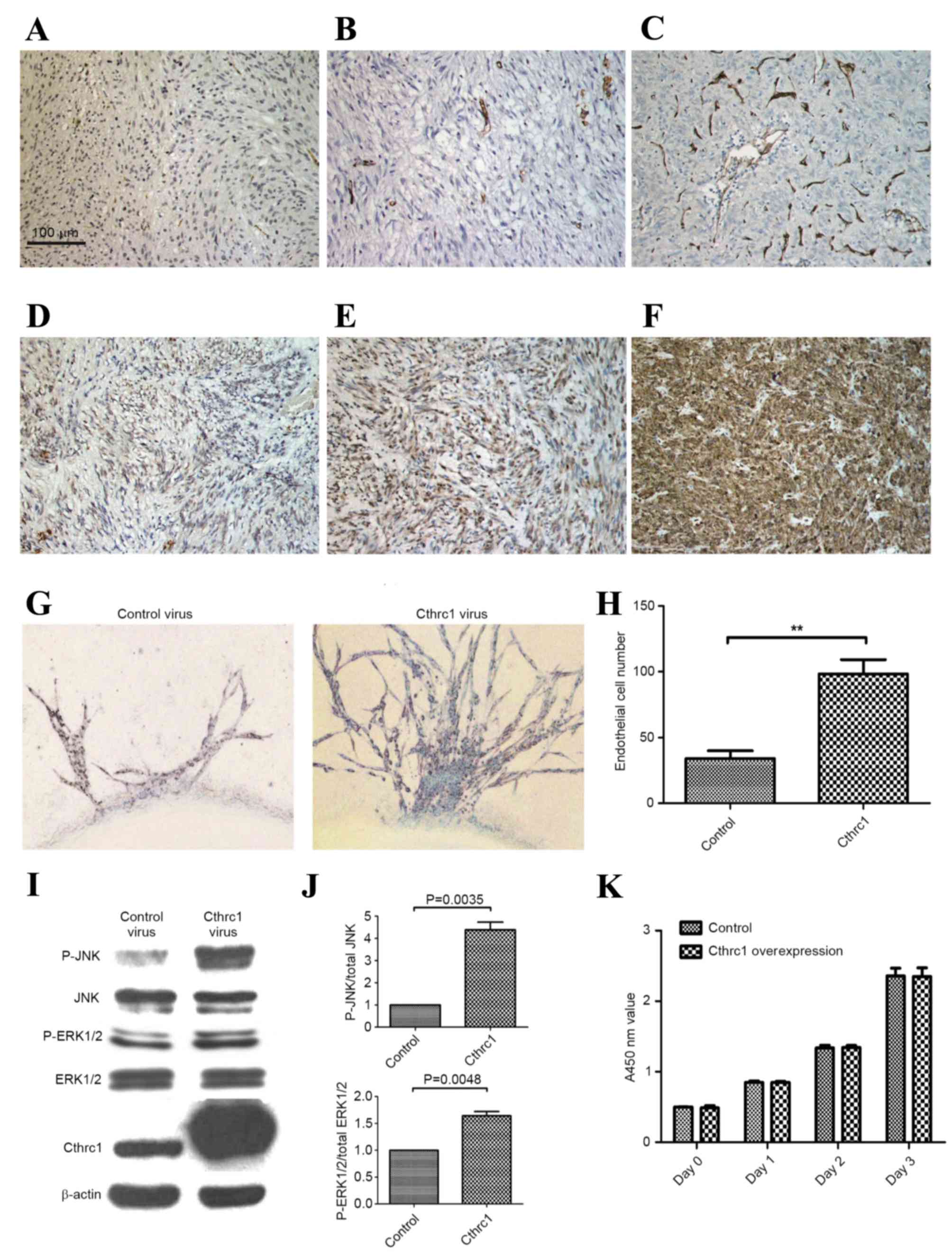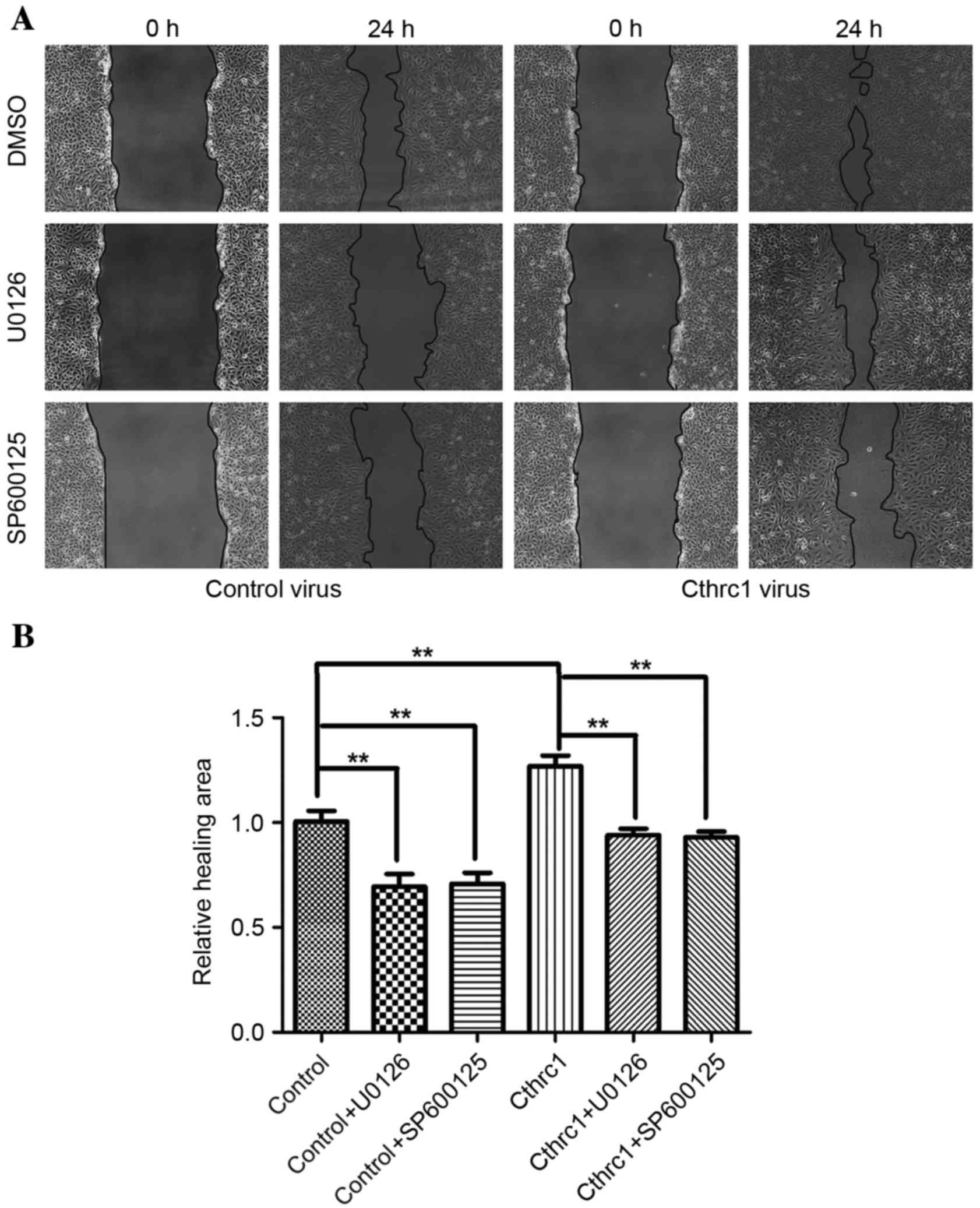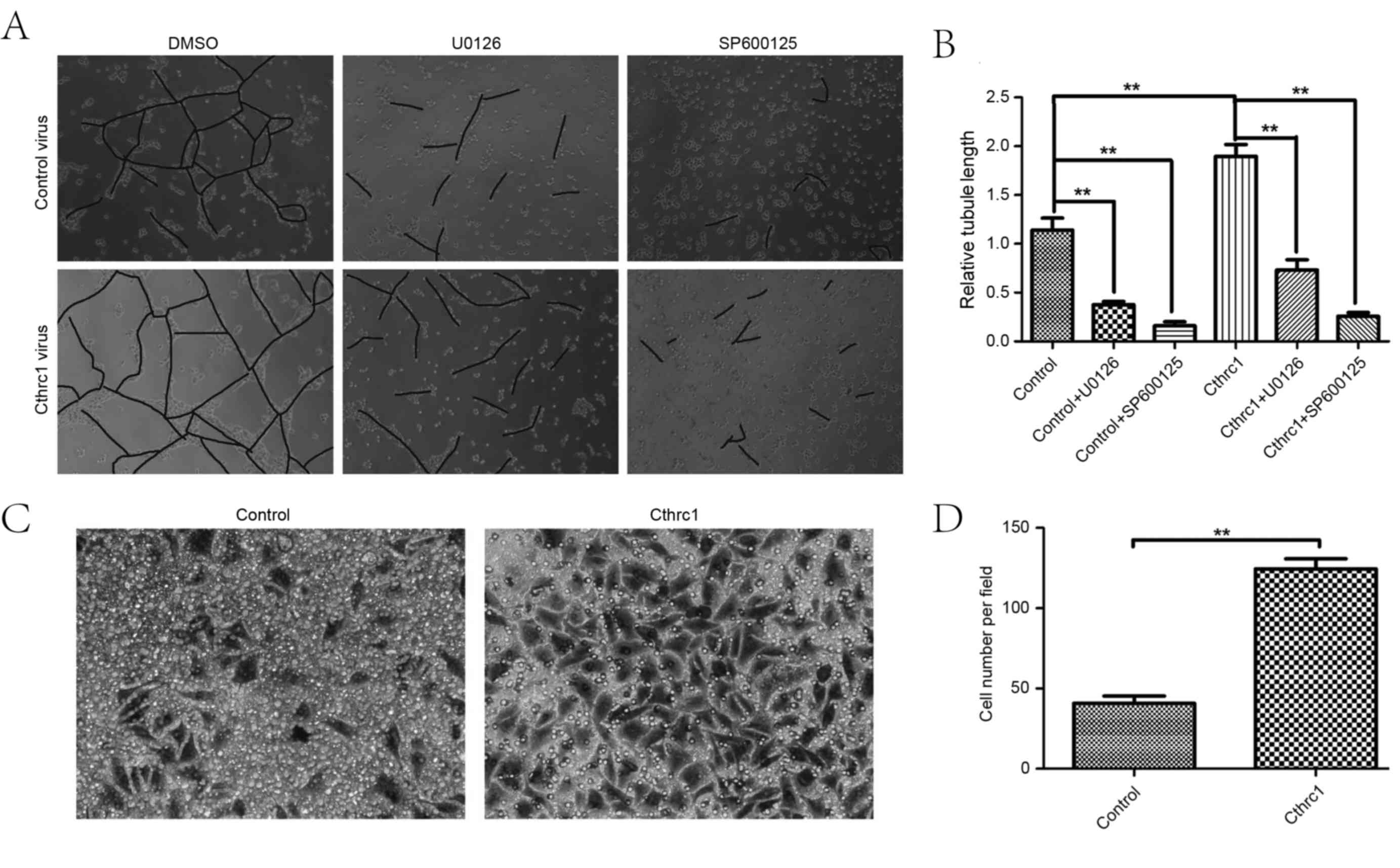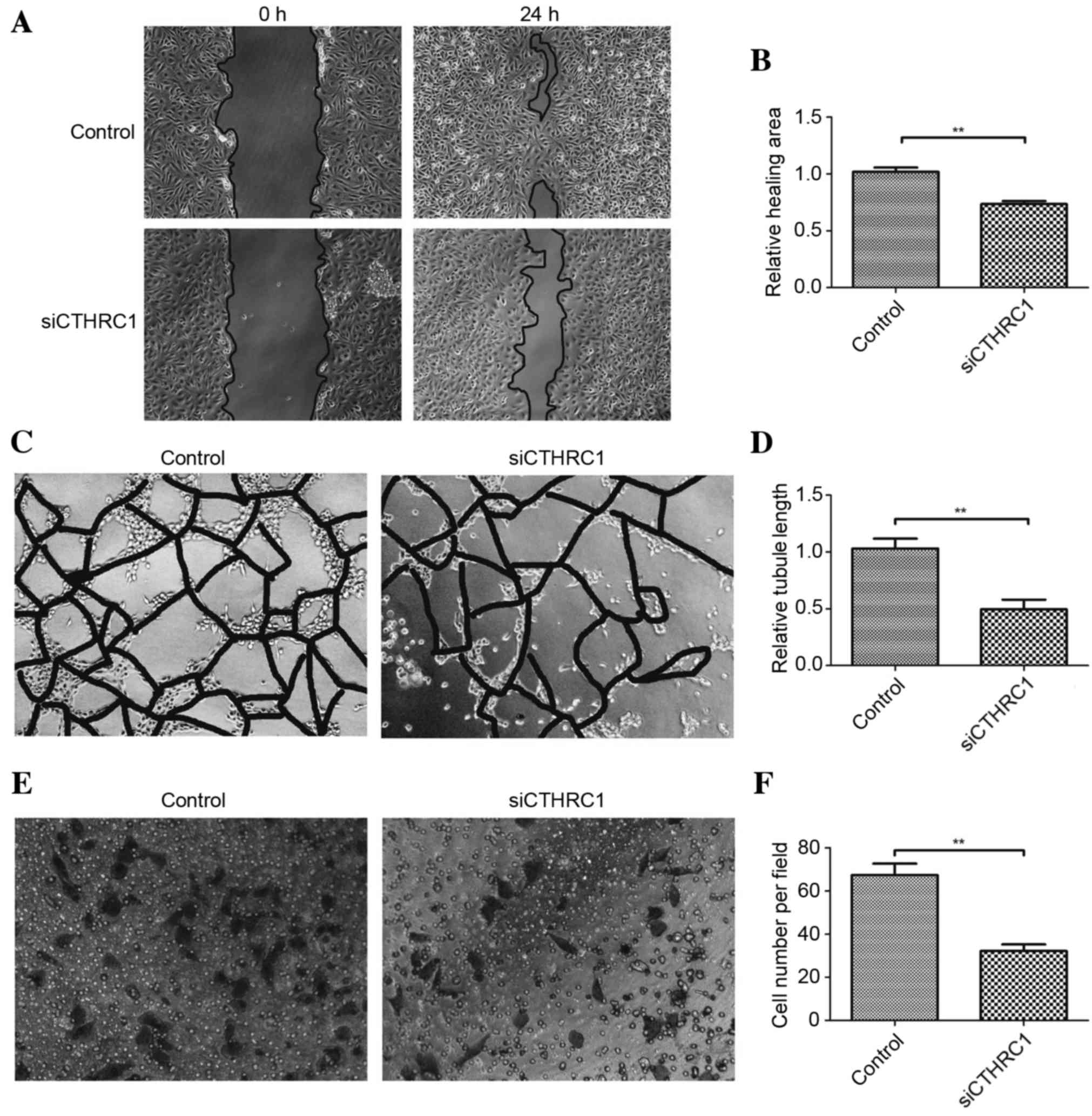Collagen triple helix repeat containing 1 promotes tumor angiogenesis in gastrointestinal stromal tumors
- Authors:
- Published online on: October 2, 2017 https://doi.org/10.3892/ol.2017.7111
- Pages: 7499-7505
Abstract
Introduction
Angiogenesis is a complex process that includes adhesion, migration, invasion, proliferation and differentiation in endothelial cells (1). Neovascularization is necessary for tumor growth by providing oxygen anxd nutrients (2). The tumor and the surrounding microenvironment, including cancer cells, endothelial cells, fibroblasts and immune cells, are associated and interact constantly (3,4). Tumors may influence the microenvironment by releasing extracellular signals, including vascular endothelial growth factor, tumor necrosis factor α, fibroblast growth factor 2 and interleukin 6 into the extracellular matrix (ECM), and promoting tumor-associated angiogenesis (5,6).
Collagen triple helix repeat containing 1 (Cthrc1) was identified to encode a secreted protein that serves a role in the cellular response to arterial injury through vascular remodeling (7). It was demonstrated that Cthrc1 is related to vascular remodeling by inhibiting collagen production and fibrogenesis, and by promoting cell migration (8). The majority of Cthrc1 studies have focused on its effects and underlying molecular mechanism, in promoting tumor cell invasion and metastasis (9–14). In the present study, it was demonstrated that increased expression of Cthrc1 protein in gastrointestinal stromal tumor (GIST) is associated with increased microvascular density (MVD) in a tissue microarray; however, to the best of our knowledge, no previous study has demonstrated the effect of Cthrc1 in endothelial angiogenesis.
Materials and methods
Immunohistochemical (IHC) staining and evaluation
Two continuous tissue microarrays (no. HDgS-GIST060CS-01) including surgical tissues from 60 GISTs were purchased from Shanghai Outdo Biotech Co., Ltd. (Shanghai, China). The 60 patients included 33 females and 27 males, with a median age of 53.4±13.70 years. The location of the samples included 5 cases in the stomach, 21 cases in the small intestine, 7 cases in the colon, 3 cases in the peritoneum and 2 cases in the mesentery. Sections were dewaxed in dimethylbenzene, hydrated in ethanol, incubated with 3% oxydol to inactivate endogenous peroxidase and incubated with a citrate solution for 30 min at 95°C for antigen retrieval. Sections were blocked with goat serum for 30 min and incubated with Anti-Cthrc1 (dilution, 1:200; cat. no. AP8778a; Abgent, San Diego, CA, USA) or anti-CD31 (dilution, 1:200; 11265-1-AP; ProteinTech, Chicago, IL, USA) at 4°C overnight. Sections were then incubated with a horseradish peroxidase (HRP)-labeled goat anti-mouse/rabbit antibody (dilution, ready to use: cat. no. D-3004; Shanghai Long Island Biotec. Co., Ltd., Shanghai, China) at 30°C for 30 min and DAB for 30 sec (Fuzhou Maixin Biotechnology Development Co., Ltd., Fuzhou, China) at room temperature, followed by hematoxylin staining and mounting. Images were captured using a microscope (CX31-LV320; Olympus Corporation, Tokyo, Japan). CD31 staining results were evaluated by the amount of vessels per ×200 fields (Fig. 1A-C). Cthrc1 staining results were evaluated as follows: -, no tumor cells stained; +, <25% tumor cells stained (Fig. 1D); ++, 25–50% tumor cells stained (Fig. 1E); +++, >50% tumor cells stained (Fig. 1F).
Cell culture
Human umbilical vein endothelial cells (HUVECs) were purchased from China Center for Type Culture Collection (Beijing, China). HUVECs were cultured in Dulbecco's modified Eagle's medium (DMEM; Gibco; Thermo Fisher Scientific, Inc., Waltham, MA, USA) supplemented with 10% fetal bovine serum (FBS; ScienCell Research Laboratories, Inc., Carlsbad, CA, USA) at 37°C in a humidified atmosphere of 5% CO2 for 72 h prior to use. U0126 (Selleck Chemicals, Houston, TX, USA) and SP600125 (Selleck Chemicals) were used to inhibit extracellular-signal-regulated kinase 1/2 (ERK1/2) and c-Jun N-terminal kinase (JNK) phosphorylation, respectively. U0126 and SP600125 were dissolved in Dimethyl sulfoxide (DMSO; Sigma-Aldrich; Merck Millipore, Darmstadt, Germany), so DMSO was used as a phosphorylation control. The final concentration of U0126 and SP600125 was 10 µM in the culture medium for the experiments.
Cthrc1-expressing adenoviral vector
An adenoviral vector expressing the human Cthrc1 coding sequence under the control of a mouse cytomegalovirus promoter was constructed as described previously (15). A control adenoviral vector expressing green fluorescent protein was prepared in parallel (15).
Small interfering RNA (siRNA) experiments
Cthrc1 was knocked down using siRNA (siCTHRC1) and the synthetic duplex oligomers 5′-CCCAUUGAAGCUAUAAUUU-3′ and 5′-AAAUUAUAGCUUCAAUGGG-3′, purchased from Shanghai GenePharma Co., Ltd. (Shanghai, China). HUVECs were transiently transfected with siRNAs using GenMute™ reagent (SignaGen Laboratories, Rockville, MD, USA), according to the manufacturer's protocol.
Aortic ring assay
A total of 6 male Sprague-Dawley rats (8-weeks old) weighing 320–345 g were purchased from Shanghai SLAC Laboratory Animal Co., Ltd. The mice were sacrificed on the day of purchase. Chloral hydrate (10%) was injected in to the abdominal cavity and the mice were sacrificed via the cervical dislocation method under the influence of the anesthetic. All animal experiments were approved by the Institutional Animal Care and Use Committee of Renji Hospital, School of Medicine, Shanghai Jiao Tong University (Shanghai, China). Aortas were harvested and cut into aortic rings of ~1 mm thickness. A total of ½ were immersed in DMEM with Cthrc1-expressing adenovirus (2×107 pfu/ml), and the other ½ were immersed in DMEM with the control adenovirus (2×107 pfu/ml) at 37°C. Following a total of 4 h, the rings were placed in 96-well culture plates and coated with liquid Matrigel™ (BD Biosciences, Franklin Lakes, NJ, USA). Following solidification of the Matrigel, 200 µl Opti-MEM (Thermo Fisher Scientific, Inc.) with 2% FBS was added. The aortic rings were incubated at 37°C, and medium was changed every two days. Images of the aortic rings (3 fields per ring) were captured (original magnification, ×200) on the eighth day with a microscope (Eclipse Ti-U; Nikon Corporation, Tokyo, Japan), the images were captured directly from the 96-well culture plates. Photoshop (version CS6; Adobe, San Jose, CA, USA) was used to sharpen the images and count the number of sprouting endothelia from the aortic ring for statistical analysis.
Cell proliferation assay
HUVECs were seeded in 96-well plates at a density of 2,000 cells/well and were incubated at 37°C overnight. Culture medium containing Cthrc1-expressing adenovirus or control adenovirus (1×107 pfu/ml) was added into various wells, and the culture medium was changed after 2 h. The optical density value of each group (six wells/group) was determined using the Cell Counting Kit-8 (CCK-8; Dojindo Molecular Technologies, Inc., Kumamoto, Japan) on days 0, 1, 2 and 3, following the manufacturer's protocol.
Western blotting
Proteins were extracted from tissue samples using total protein extraction kits (cat. no. C510003; Sangon Biotech Co., Ltd., Shanghai, China). The protein concentration was determined using a BCA Protein Assay kit (cat. no. 23252; Thermo Fisher Scientific, Inc.). Proteins (40 µg) were loaded and electrophoresed on a 10% SDS-PAGE gel. Proteins were transferred to a nitrocellulose membrane (EMD Millipore, Billerica, MA, USA), which was blocked using 5% milk for 2 h at room temperature, and then incubated with the primary antibodies at 4°C overnight. An HRP-labeled secondary antibody (dilution, 1:5,000; cat. no. 7074; Cell Signaling Technology, Inc.) was added and incubated at room temperature for 1 h. The immunoreactive signals were detected using Super Signal West Femto Maximum Sensitivity Substrate (Thermo Fisher Scientific, Inc.). The primary antibodies were anti-Cthrc1 (dilution, 1:1,000; cat. no. AP8778a; Abgent), anti-ERK1/2 (dilution, 1:1,000; cat. no. 9102; Cell Signaling Technology, Inc.), anti-phospho (P)-ERK1/2 (dilution, 1:1,000; cat. no. 4370; Cell Signaling Technology, Inc.), anti-JNK (dilution, 1:1,000; cat. no. 9252; Cell Signaling Technology, Inc.), anti-P-JNK (dilution, 1:1,000; cat. no. 4668; Cell Signaling Technology, Inc.) and anti-β-actin (dilution, 1:4,000; cat. no. 8457; Cell Signaling Technology, Inc.). Western blots were analyzed densitometrically using ImageJ software version 1.45S (National Institutes of Health, Bethesda, MD, USA).
Tubule formation assay
Matrigel was pipetted into 48-well plates and allowed to polymerize for 30 min at 37°C. HUVECs (6×104) were seeded on Matrigel in 200 µl culture medium. The plates were incubated at 37°C for 6–8 h, prior to the capture of images using an Eclipse Ti-U microscope (magnification, ×100). ImageJ was used to measure the tube length in µm. The sum of tube length was determined for statistical analysis.
Scratch wound assay
HUVECs were cultured to full confluence in 6-well culture plates. The cell layer was scratched using a sterile pipette tip and the scratched area was imaged with an Eclipse Ti-U microscope (original magnification, ×200). Following incubation at 37°C for 24 h, the scratched area was imaged again. ImageJ was used to measure the scratched area in µm2. The healing area was evaluated for statistical analysis.
Cell invasion assay
A Transwell chamber (24-well insert; pore size 8 µm; EMD Millipore) was coated with Matrigel for 6 h prior to the invasion assay. A total of 2×105 HUVECs were plated in the Transwell chamber with 200 µl FBS-free DMEM. DMEM (600 µl) containing 20% FBS was added to the lower chambers of the 24-well plates. After 36 h of incubation at 37°C, the cells that had invaded through the pores were fixed using 4% paraformaldehyde (25 min) and stained using 0.5% crystal violet (30 min) at room temperature, and the number of cells was counted under a ×200 Eclipse Ti-U light microscope.
Statistical analysis
Each individual experiment was conducted with three or five replicates. All data are presented as the mean ± standard error, and were analyzed using the Student's t-test or Mann-Whitney U test with SPSS (version 18.0; SPSS, Inc., Chicago, IL, USA). P<0.05 was considered to indicate a statistically significant difference.
Results
MVD is associated with the tumor site and Cthrc1 protein expression level
Quantification of the IHC staining demonstrated that there was a significant decrease in MVD in tumors located in the stomach compared with non-stomach-located tumors (8.19±6.97 vs. 16.48±17.04, respectively; P=0.003; Table I). GIST with increased expression of Cthrc1 protein exhibited increased MVD compared with GIST with decreased expression of Cthrc1 (14.44±15.35 vs. 7.67±7.05, respectively; P=0.021; Table I). Statistical analysis indicated that MVD was not significantly associated with sex, mitotic index, tumor size or National Institutes of Health risk grade (Table I).
Effect of Cthrc1 expression on aortic ring sprouting
To investigate the effect of Cthrc1 on angiogenesis, an aortic ring assay was performed. The aortic ring assay demonstrated that Cthrc1-overexpressing aortic rings developed a significantly increased number of sprouting endothelial cells compared with the control (P<0.001), indicating that Cthrc1 serves an important role in angiogenesis (Fig. 1G and H).
Effect of Cthrc1 overexpression on HUVEC proliferation, tubule formation, migration and invasion
Densitometric analysis of western blots (Fig. 1I) demonstrated significantly increased ratios of P-JNK/total JNK (P=0.004) and P-ERK1/2/total ERK1/2 (P=0.005) in HUVECs transfected with Cthrc1-expressing adenovirus compared with HUVECs transfected with control adenovirus (Fig. 1J). CCK-8 results demonstrated that HUVEC proliferation was not significantly affected by Cthrc1-expressing adenovirus (Fig. 1K), indicating that Cthrc1 promotes aortic ring sprouting without promoting HUVEC proliferation. The scratch wound assay and the tubule formation assay revealed that Cthrc1 protein overexpression was able to increase the migratory function of HUVECs (Fig. 2A and B), and increase HUVEC tubule formation (Fig. 3A and B). The cell invasion assay demonstrated that Cthrc1 protein overexpression was able to increase HUVEC invasion (Fig. 3C and D). Decreased HUVEC migration and tubule formation were observed following treatment with the kinase inhibitors U0126 and SP600125 (Figs. 2A and B, 3A and B), suggesting that ERK1/2 and JNK phosphorylation may be the underlying molecular mechanism of promotion of angiogenesis by Cthrc1.
Effect of Cthrc1 knockdown on HUVEC tubule formation, migration and invasion
Following Cthrc1 knockdown using siRNA in HUVECs, the ability of HUVECs to form tubules, migrate and invade was significantly decreased (Fig. 4), indicating that inhibition of Cthrc1 protein expression may be a promising method of inhibiting GIST angiogenesis.
Discussion
Previous studies have demonstrated that patients with increased expression of Cthrc1 protein have a poorer prognosis compared with those with decreased expression, a phenomenon that has been observed in numerous types of tumor (9–12,16). Tumor MVD is negatively associated with tumor prognosis. The present study demonstrated that Cthrc1 protein expression is associated with GIST MVD. The aortic ring assay demonstrated that Cthrc1 was able to promote aortic ring sprouting. The wound healing assay, cell invasion assay and tubule formation assay demonstrated that Cthrc1 was able to promote HUVEC migration, invasion and tubule formation. The results of the present study indicated that Cthrc1 serves an important role in GIST angiogenesis and may explain why patients with increased expression of Cthrc1 protein have a poorer prognosis.
Cthrc1 has been demonstrated to promote the phosphorylation of ERK and JNK in colon cancer (12) and GIST (9), respectively. Previous studies have revealed that the increase in phosphorylation of ERK and JNK may promote HUVEC migration and tubule formation (17–19). In the present study, it was demonstrated that Cthrc1 was able to promote ERK and JNK phosphorylation in HUVECs, and inhibition of ERK and JNK phosphorylation may decrease HUVEC migration and tubule formation. These results indicate that the pro-angiogenic effect of Cthrc1 is associated with the phosphorylation of ERK and JNK.
The planar cell polarity (PCP) signaling pathway is a highly conserved signaling cascade that coordinates epithelial and axonal morphogenic movements during organ development by regulating angiogenesis (20). Inhibition of the PCP signaling pathway disrupts endothelial cell growth, polarity and migration (20–22). Cthrc1 is a Wnt co-factor protein that selectively activates the Wnt/PCP signaling pathway by stabilizing ligand-receptor interactions (9,23,24). Cthrc1 may activate the PCP signaling pathway; however, it was demonstrated to suppress the canonical Wnt signaling pathway in human embryonic kidney-293T and GIST cells (9,23). Therefore, Cthrc1 may activate the PCP signaling pathway in HUVECs and promote tumor angiogenesis.
Collagen matrix deposition in ECM is an important process in the inhibition of tumor invasion and angiogenesis (25,26). Cthrc1 may reduce collagen type I mRNA and protein levels in fibroblasts, resulting in decreased collagen synthesis and contributing to vascular remodeling (27). Matrix metalloproteinase 9 (MMP9) is an important factor in collagen degradation (28). Cthrc1 has been demonstrated to promote MMP9 secretion in colon cancer (12). Therefore, inhibiting Cthrc1 may increase collagen matrix deposition and decrease tumor invasion and angiogenesis.
Although the present study has revealed certain underlying molecular mechanisms regarding the pro-angiogenic effect of Cthrc1, further studies in vivo and in vitro are required to validate these experimental findings.
Acknowledgements
The present study was supported by the National Natural Science Foundation of China (grant no. 81270474). The authors of the present study thank Professor Xiong Ma (Shanghai Jiao-Tong University, Shanghai, China) for providing the Cthrc1-expressing adenovirus and the control adenovirus.
References
|
Carmeliet P and Jain RK: Angiogenesis in cancer and other diseases. Nature. 407:249–257. 2000. View Article : Google Scholar : PubMed/NCBI | |
|
Folkman J: Tumor angiogenesis: Therapeutic implications. N Eng J Med. 285:1182–1186. 1971. View Article : Google Scholar | |
|
Pollard JW: Tumour-educated macrophages promote tumour progression and metastasis. Nat Rev Cancer. 4:71–78. 2004. View Article : Google Scholar : PubMed/NCBI | |
|
Kalluri R and Zeisberg M: Fibroblasts in cancer. Nat Rev Cancer. 6:392–401. 2006. View Article : Google Scholar : PubMed/NCBI | |
|
Joyce JA and Pollard JW: Microenvironmental regulation of metastasis. Nat Rev Cancer. 9:239–252. 2009. View Article : Google Scholar : PubMed/NCBI | |
|
Lin WW and Karin M: A cytokine-mediated link between innate immunity, inflammation, and cancer. J Clin Invest. 117:1175–1183. 2007. View Article : Google Scholar : PubMed/NCBI | |
|
Pyagay P, Heroult M, Wang Q, Lehnert W, Belden J, Liaw L, Friesel RE and Lindner V: Collagen triple helix repeat containing 1, a novel secreted protein in injured and diseased arteries, inhibits collagen expression and promotes cell migration. Circ Res. 96:261–268. 2005. View Article : Google Scholar : PubMed/NCBI | |
|
Durmus T, LeClair RJ, Park KS, Terzic A, Yoon JK and Lindner V: Expression analysis of the novel gene collagen triple helix repeat containing-1 (Cthrc1). Gene Expr Patterns. 6:935–940. 2006. View Article : Google Scholar : PubMed/NCBI | |
|
Ma MZ, Zhuang C, Yang XM, Zhang ZZ, Ma H, Zhang WM, You H, Qin W, Gu J, Yang S, et al: CTHRC1 acts as a prognostic factor and promotes invasiveness of gastrointestinal stromal tumors by activating Wnt/PCP-Rho signaling. Neoplasia. 16(265–278): e1–13. 2014. | |
|
Hou M, Cheng Z, Shen H, He S, Li Y, Pan Y, Feng C, Chen X, Zhang Y, Lin M, et al: High expression of CTHRC1 promotes EMT of epithelial ovarian cancer (EOC) and is associated with poor prognosis. Oncotarget. 6:35813–35829. 2015.PubMed/NCBI | |
|
Ke Z, He W, Lai Y, Guo X, Chen S, Li S, Wang Y and Wang L: Overexpression of collagen triple helix repeat containing 1 (CTHRC1) is associated with tumour aggressiveness and poor prognosis in human non-small cell lung cancer. Oncotarget. 5:9410–9424. 2014. View Article : Google Scholar : PubMed/NCBI | |
|
Kim HC, Kim YS, Oh HW, Kim K, Oh SS, Kim JT, Kim BY, Lee SJ, Choe YK, Kim DH, et al: Collagen triple helix repeat containing 1 (CTHRC1) acts via ERK-dependent induction of MMP9 to promote invasion of colorectal cancer cells. Oncotarget. 5:519–529. 2014. View Article : Google Scholar : PubMed/NCBI | |
|
Wang P, Wang YC, Chen XY, Shen ZY, Cao H, Zhang YJ, Yu J, Zhu JD, Lu YY and Fang JY: CTHRC1 is upregulated by promoter demethylation and transforming growth factor-β1 and may be associated with metastasis in human gastric cancer. Cancer Sci. 103:1327–1333. 2012. View Article : Google Scholar : PubMed/NCBI | |
|
Liu X, Liu B, Cui Y, Wang F, Sun H and Lv F: Collagen triple helix repeat containing 1 (Cthrc1) is an independently prognostic biomarker of non-small cell lung cancers with cigarette smoke. Tumour Biol. 35:11677–11683. 2014. View Article : Google Scholar : PubMed/NCBI | |
|
Bian Z, Miao Q, Zhong W, Zhang H, Wang Q, Peng Y, Chen X, Guo C, Shen L, Yang F, et al: Treatment of cholestatic fibrosis by altering gene expression of Cthrc1: Implications for autoimmune and non-autoimmune liver disease. J Autoimmun. 63:76–87. 2015. View Article : Google Scholar : PubMed/NCBI | |
|
Gu L, Liu L, Zhong L, Bai Y, Sui H, Wei X, Zhang W, Huang P, Gao D, Kong Y and Lou G: Cthrc1 overexpression is an independent prognostic marker in gastric cancer. Hum Pathol. 45:1031–1038. 2014. View Article : Google Scholar : PubMed/NCBI | |
|
Wu F, Song H, Zhang Y, Zhang Y, Mu Q, Jiang M, Wang F, Zhang W, Li L, Li H, et al: Irisin induces angiogenesis in human umbilical vein endothelial cells in vitro and in Zebrafish Embryos in vivo via activation of the ERK signaling pathway. PLoS One. 10:e01346622015. View Article : Google Scholar : PubMed/NCBI | |
|
Lee OH, Kim YM, Lee YM, Moon EJ, Lee DJ, Kim JH, Kim KW and Kwon YG: Sphingosine 1-phosphate induces angiogenesis: Its angiogenic action and signaling mechanism in human umbilical vein endothelial cells. Biochem Biophys Res Commun. 264:743–750. 1999. View Article : Google Scholar : PubMed/NCBI | |
|
Jin YJ, Park I, Hong IK, Byun HJ, Choi J, Kim YM and Lee H: Fibronectin and vitronectin induce AP-1-mediated matrix metalloproteinase-9 expression through integrin α(5)β(1)/α(v)β(3)-dependent Akt, ERK and JNK signaling pathways in human umbilical vein endothelial cells. Cell Signal. 23:125–134. 2011. View Article : Google Scholar : PubMed/NCBI | |
|
Cirone P, Lin S, Griesbach HL, Zhang Y, Slusarski DC and Crews CM: A role for planar cell polarity signaling in angiogenesis. Angiogenesis. 11:347–360. 2008. View Article : Google Scholar : PubMed/NCBI | |
|
Ju R, Cirone P, Lin S, Griesbach H, Slusarski DC and Crews CM: Activation of the planar cell polarity formin DAAM1 leads to inhibition of endothelial cell proliferation, migration, and angiogenesis. Proc Natl Acad Sci USA. 107:pp. 6906–6911. 2010, View Article : Google Scholar : PubMed/NCBI | |
|
Descamps B, Sewduth R, Tojais Ferreira N, Jaspard B, Reynaud A, Sohet F, Lacolley P, Allières C, Lamazière JM, Moreau C, et al: Frizzled 4 regulates arterial network organization through noncanonical Wnt/planar cell polarity signaling. Circ Res. 110:47–58. 2012. View Article : Google Scholar : PubMed/NCBI | |
|
Yamamoto S, Nishimura O, Misaki K, Nishita M, Minami Y, Yonemura S, Tarui H and Sasaki H: Cthrc1 selectively activates the planar cell polarity pathway of Wnt signaling by stabilizing the Wnt-receptor complex. Dev Cell. 15:23–36. 2008. View Article : Google Scholar : PubMed/NCBI | |
|
Kelley MW: Leading Wnt down a PCP path: Cthrc1 acts as a coreceptor in the Wnt-PCP pathway. Dev Cell. 15:7–8. 2008. View Article : Google Scholar : PubMed/NCBI | |
|
Chang C and Werb Z: The many faces of metalloproteases: Cell growth, invasion, angiogenesis and metastasis. Trends Cell Biol. 11:S37–S43. 2001. View Article : Google Scholar : PubMed/NCBI | |
|
Cox G and O'Byrne KJ: Matrix metalloproteinases and cancer. Anticancer Res. 21:4207–4219. 2001.PubMed/NCBI | |
|
LeClair R and Lindner V: The role of collagen triple helix repeat containing 1 in injured arteries, collagen expression, and transforming growth factor beta signaling. Trends Cardiovasc Med. 17:202–205. 2007. View Article : Google Scholar : PubMed/NCBI | |
|
Burg-Roderfeld M, Roderfeld M, Wagner S, Henkel C, Grötzinger J and Roeb E: MMP-9-hemopexin domain hampers adhesion and migration of colorectal cancer cells. Int J Oncol. 30:985–992. 2007.PubMed/NCBI |













